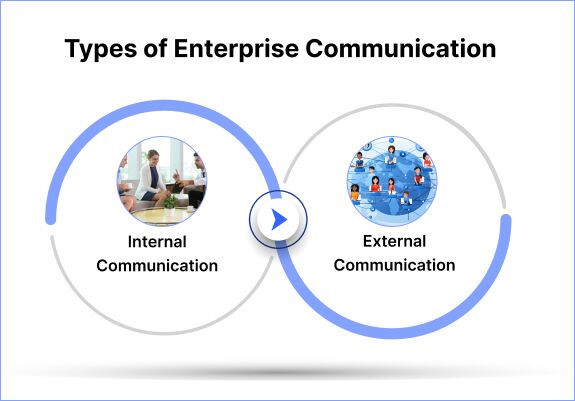
Do you know what enterprise communication solutions are? Well, that is what this blog post is all about. Imagine this: you’ve just finished a killer presentation for a valuable client, but your team is scattered across the globe with different time zones and working hours. Sending an email seems of no use because it will be lost in the pile.
Workplace communication statistics show that 86% of employees and executives cite the lack of effective collaboration and communication as the main cause of workplace failures. Another report from Panopto says that employees waste 5.3 hours every week waiting for data from their colleagues – or recreating information that already exists.
Sounds familiar?
Today, as enterprises expand their global presence, their teams become increasingly distributed, and remote work becomes the standard. Achieving seamless communication for a large company can be a real struggle. This is where Enterprise Communication Solutions can act as a game changer.
Let’s learn more!
What is Enterprise Communication?

Enterprise communication means how a company, typically with a large employee count, shares information inside and out. It is the entire ecosystem of tools, practices, and strategies that organizations use to exchange information, ideas, and messages.
Enterprise communication typically involves employees, departments, and stakeholders connecting through various channels. You can think of enterprise communication as the ‘nervous system; of a business or an organization.
Types of Enterprise Communication

Internal Communication is the flow of information within the company. Formal communication inside the business happens in the form of official announcements, company policies, and directives. Informal communication includes day-to-day conversations, casual interactions, team meetings, etc.
External Communication involves interactions with people outside the business or company. Usually, these ‘people’ are potential and existing customers, suppliers, investors, partners, media personnel, government and regulatory bodies, etc. External communication is done for various purposes, such as sales and marketing, public relations, and providing support and assistance.
What are Enterprise Communication Solutions, or ECS?
“48% of organizations say their top collaboration hurdle is ‘ineffective communication’ between team members.” (Source: Planview).
Enterprise communication solutions, or ECS, bridge the gap between ineffective communication and a seamless collaborative work environment. These systems refer to software solutions designed to facilitate effective communication and collaboration within large organizations, streamlining workflows, boosting productivity, and fostering a cohesive work environment.
ECS often encompasses various tools and platforms for messaging, voice and video conferencing, email, document sharing, and other forms of communication.
Different Types of Enterprise Communication Solutions
1. Cloud-Based Enterprise Communication Solutions
In light of rapidly evolving business requirements, driven by companies operating across diverse time zones and geographic regions, and the growing prevalence of remote work and mobile communication, cloud-based enterprise communication systems offer a solution.
These systems enable organizations to host their infrastructure remotely, known as “in the cloud,” across multiple locations. By doing so, organizations can ensure backup and protection while simultaneously freeing up on-premises resources. Such systems encompass various communication platforms, spanning from telephony to other forms of digital communication.
2. UCaaS or Unified Communications As A Service
It is the gold standard for communication solutions. UCaaS combines various communication channels, such as voice, video, messaging, email, and conferencing, into a single platform. This enables users to communicate across multiple channels by switching seamlessly between the channels depending on the situation. UCaaS or Unified Communications is popular with big firms. It combines tools in one place and works well with other apps.
3. On-Premise Enterprise Communication Systems
Specially designed to cater to the needs of enterprises seeking high reliability and security. Some of the standard features offered by on-premise enterprise communication systems are voice, video, instant messaging, conferencing, and media sharing. Other unique features include directory searching, message broadcasting, location tracking, and sharing.
Communication software and hardware are physically installed and maintained within a company’s own data center or server room. This approach offers businesses a high degree of control over the communication infrastructure.
On-premise enterprise communication systems serve as a great workplace tool to meet the rising need for secured internal communication, increased employee productivity, faster decisions, and better organizational alignment.
4. Team Collaboration Platforms
Designed to reinforce teamwork and cooperation within organizations, Team Collaboration Platforms offer a range of features to streamline communication and enhance productivity.
Firstly, they provide robust project management tools that allow teams to efficiently manage tasks, assign deadlines, and track project progress. Additionally, these platforms facilitate seamless file sharing and document collaboration, enabling team members to collaborate on documents, presentations, and other files in real-time.
Furthermore, they offer video conferencing and screen-sharing capabilities, which are essential for hosting virtual meetings and brainstorming sessions, regardless of team members’ locations. Lastly, team collaboration platforms often include discussion forums and chat rooms, fostering open communication and knowledge sharing among team members in a collaborative digital environment.
5. Enterprise Communication SDKs and APIs

SDKs and APIs are tools and interfaces that enable communication functionalities within custom applications. SDKs and APIs empower developers to seamlessly integrate powerful communication features into their apps, so they don’t need to build everything from the beginning.
Here’s a breakdown of each and how they work together to contribute to the bigger picture:
Software Development Kits or SDKs
SDKs are bundles of software tools, libraries, and documentation that simplify the process of integrating communication functionalities into third-party applications. It saves developers time and effort, as they don’t need to write the code from scratch, but rather quickly integrate the pre-built components and models within their applications. Usually, SDKs are available for various platforms, including iOS, Android, desktop environments, and the web.
Application Programming Interface or API
APIs, on the other hand, are sets of rules, commands, and protocols that define how software components interact and communicate with each other. A simple example of APIs is that several websites and apps allow you to sign in using your existing social media accounts, like Facebook or Google. This is done through APIs.
Benefits of Enterprise Communication Tools
Do enterprise communication solutions deliver on their promises? The answer is- Absolutely! Their numerous advantages can greatly enhance collaboration and productivity within your organization.
Let’s explore how these solutions can revolutionize your organization’s communication and collaboration.
Reduced Email Overload

Email overload is real. Almost 306.4 billion emails are sent and received each day, and “an average employee spends 28% of their workweek managing emails.” Imagine all the productive work that could be accomplished if that time was freed up!
Enterprise communication solutions are a great way to reduce the reliance on email as the primary means of communication. Those quick questions, updates and similar information can be shared via instant messaging or chat applications that are a feature of ECS. There is no need for lengthy email chains when you and your teams can discuss everything in real-time with a centralized system at your disposal.
Supports Hybrid Workforce
Time has changed, and today’s workforce is no longer present in the same office. Hybrid culture is the new norm where employees work both remotely and in-office. ECS solutions offer seamless communication and collaboration tools accessible from anywhere.
A hybrid team can utilize video conferencing and instant messaging for virtual meetings and collaboration sessions. Remote workers can join meetings from their place, while those in the office can join from their respective meeting rooms. ECS ensures that all team members can actively participate and effectively contribute, regardless of their location.
Enhanced Collaboration and Productivity

You must already be familiar with the frustration of waiting for an email response, especially when there’s a deadline. ECS enables employees to share documents, track project progress, and connect in real-time. Suppose you need clarification about a project from your colleague on an urgent basis. Using the instant messaging feature of ECS, you can receive an immediate response. This helps reduce delays and boosts your productivity.
Protects Sensitive Information

The security of data is a paramount concern for all businesses these days. Taking your data over unsecured platforms can lead to security breaches. For instance, you are a healthcare firm dealing with sensitive patient health data. ECS solutions employ robust security measures like end-to-end encryption to secure messages and data shared between users. Additionally, access controls can be implemented so that only authorized users can access highly sensitive information.
Increased Employee Satisfaction and Engagement
Communication solutions allow employees to work remotely or flexibly, promoting a better work-life balance. Employees feel more connected and informed, leading to higher morale and job satisfaction.
Company Communication Strategy: Common Challenges & Best Practices
Today’s business environment is quite complex. Enterprise leaders must find ways to address common challenges and follow effective approaches to overcome them. Here’s a breakdown of common enterprise communication challenges along with corresponding best practices:
Challenge: Siloed Communication

The cost of communication silos is high. According to statistics, “Siloed contact center agents spend 15% of their time each day trying to navigate communication hurdles to get information to serve customers.” (Source: The ROI of Uniting Unified Communications and Contact Center, Aberdeen). Furthermore, “A 200-agent contact center loses $1.5M in labor costs annually because of siloed communications.” (Source: Aberdeen)
When teams or departments within an organization operate independently, it results in fragmented communication, commonly referred to as siloed communication. For instance, one department, say marketing, develops a campaign without realizing that the other department, say sales, is already working on a similar initiative.
Best Practice
An enterprise communication solution provides a central hub for all communication and collaboration. Project management tools like media sharing, instant messaging, real-time collaboration, etc., within the ECS help in fostering a culture of open communication, transparent inter-departmental communication, and breaking down organizational silos.
Challenge: Information Overload
The average team wastes more than 20 hours per month due to poor collaboration and communication. That’s 6 work weeks per year that teams are not being productive. (Source: Planview)
Employees are bombarded with overwhelming emails, notifications, and messages daily, making it difficult to prioritize and manage information effectively. What if an important project-related message gets lost in the bundle of other messages?
Best Practice
Set specific channels for different communication types, such as instant messaging for quick updates, emails for formal communication, and project management tools for task-related team discussions.
Challenge: Remote Work Disconnect

Remote employees may face difficulties collaborating with in-office team members, feeling isolated and disconnected from the organizational culture. This isn’t simply speculation; there are solid facts to support this, as follows:
- 40% of employees worldwide believe there is a lack of collaboration and communication in their company.
- 28% of employees report poor communication as the number one reason for not being able to meet deadlines.
- 33% of employees point to a lack of up-front communication as having the most negative impact on employee morale.
- 43% of on-site employees state that due to poor communication, they lose trust in leadership.
Source – BROSIX
Best Practice
Statistics reveal that “85% of employees report they are most motivated when the executive management gives them regular updates on the company news and other related information.” Leverage ECS tools that support remote collaboration and engagement. Use video conferencing to regularly schedule virtual team meetings and team-building activities to maintain a sense of connectedness among the employees.
Challenge: Security and Compliance Concerns
The use of unsecured communication channels can lead to accidental leakage or unauthorized access to sensitive business information. This can put the company at risk for breaches.
Best Practice
Choose an ECS that implements robust security measures and compliance controls. This may include encryption for data transmission, authentication mechanisms, regular security audits, and compliance assessments.
We must remember that there is no single, defined strategy to achieve success. A business must assess whether its communication strategy is working or not. Also, keeping in mind that there’s always room for improvement, enhancements can be made.
How to Select the Right Enterprise Communication System?
Companies with engaged employees report 2.5 times higher revenues than those with low engagement.
Enterprise communication solutions are a great way to boost engagement among employees, leading to higher productivity and thus revenue. While there are several platforms offering enterprise communication solutions, you need to filter and select the one that best aligns with your specific requirements. Here’s how you can do it:

Assess Organizational Needs and Goals
If you are a large multinational company, then opting for a UCaaS system would be an ideal choice to connect geographically dispersed teams. However, small startups and medium-sized businesses might prefer a more cost-effective and simple solution, like a team collaboration platform. So, the first step should be to perform a self-assessment. Getting answers to these questions will be helpful:
- Are there information silos hindering collaboration?
- Is email overload impacting productivity?
- Are remote work challenges affecting team dynamics?
- What are your biggest communication pain points?
While gathering answers to the above questions, you may gather input from your teams and departments by performing the following:
- Conduct surveys to understand your team’s communication preferences.
- Do they rely heavily on email or prefer real-time messaging?
- What features do they find most valuable for their daily tasks?
Define Your Features and Functionality Needs
Look for core features and functionalities like voice calls, video conferencing, instant messaging, file-sharing capabilities, and mobile app accessibility. Further, based on your specific needs, explore advanced features like presence indicators, integration with existing CRM, and other business tools. Compare the features offered by different enterprise communication providers to shortlist a few suitable ones.
Useful Tip: You may want to opt for a solution that is packed with a bundle of features. But wait, what is the benefit if you don’t use them? It is always a better idea to consider a solution that offers features specific to your business needs.
Assess Total Cost of Ownership
Many businesses make the mistake of choosing a solution based on the upfront costs of implementing the system, however, you must not ignore the ongoing expenses. These expenses usually include subscription fees, per-user fees, maintenance, support charges, and training costs. Remember that not every provider offers a transparent pricing structure; often, hidden charges become a reason for disappointment during later stages.
Consider User Adoption and Training
While choosing an enterprise communication platform, you must keep the user-friendliness and intuitiveness of the platform in mind. A platform with these features can help minimize training and ensure quick user adoption. You may look for vendors who offer comprehensive training and support to help your team members or employees navigate the system and leverage its benefits.
Key Takeaway!
Research carried out by McKinsey shows that well-connected teams can increase their productivity by 20 to 25%. On the other hand, poor communication is responsible for 70% of corporate errors, according to the US research firm Gartner.
As companies grow, communication becomes crucial. By implementing a comprehensive enterprise communication solution that integrates features like instant messaging, video conferencing, and file sharing, you’re not just facilitating information exchange, you’re fostering a culture of transparency, boosting employee morale, and ultimately propelling your business toward long-term growth.




























